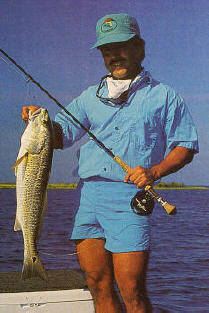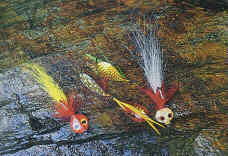May 16, 2011
By admin
Teasing can triple the hookups for experienced or novice anglers.
By Chris Christian
 Teasing brought this nice red to hand. |
I've seen a lot of things in the 35-odd years I've been chasing fish with a rod and reel, but I have to admit, this was the first time I'd ever been charged by a pod of redfish.
There were seven or eight of them. They were coming fast. And they were obviously excited.
Advertisement
You could kind of tell all this from the way they were trying to catch the gold spoon that was skipping along the surface of the water ahead of them. They were also a little bit irritated, largely because Jim Dupre was doing his level best to keep that spoon just out of their reach. It reminded me of running rapidly around the yard holding a large, juicy steak bone in your hand while a pack of dogs does their best to alter the situation in their favor.
It wasn't exactly as haphazard as it sounds because as soon as the pod got within 80 feet of the boat, Max Dufflocp started working fly line through the air. At 50 feet, Dupre suddenly jerked the spoon away from the fish at the instant that Max's topwater hair bug landed in the middle of the pod.
Advertisement
That gave the redfish something to vent their frustration on. The bug never stood a chance.
Better yet, this wasn't an accidental encounter. In fact, we had been following this particular school of redfish and pulling small, fired-up pods of them away from the larger congregation all morning. By doing that, we were able to catch our reds and have them too. Our battles were conducted well away from the main school, which helped keep those fish from bolting.
The technique Dupre was demonstrating works well with any kind of tackle and could be especially helpful when a novice angler is aboard and you want him or her to catch a lot of fish. That certainly helps spark greater interest in fishing. This kind of teasing, though, is especially useful for flyfishermen. It can help lure reds within range of the beginning angler, but veteran fishermen can use it as well, especially under conditions when blind casting is a problem, such as on windy days.
Dupre came up with the technique simply because he was tired of poling all day.
"It has made my life a lot easier," says the Gainesville guide who often prowls the flats around Cedar Key. "Before I stumbled on this teasing technique, I would have to pole into casting position on the school carefully so as not to spook them. Then, once my angler got hooked up, the school would usually spook. I'd have to go looking for fish all over again, starting almost from scratch.
"Now," he says, "I don't have to go to the fish, I just pull a small pod off the school and bring them to me. That way, I can stay with the same school throughout the tide. And I can get my angler onto a whole lot more fish than I ever could when I was chasing them one cast at a time. If we could hook up with five fish before, we can get 15 now."
The actual teasing technique is simplicity in itself. In fact, you don't even need visual contact with the fish. This can be a major asset in times of low light and reduced visibility, or if the water is too dirty to spot fish at a distance, as it is in much of the state.
Using this method, you can locate fish in shallows where you could never see them, get them fired up and ready to accept a lure, then pull small groups away from the area without disturbing the others.
The key to the technique is a standard gold spoon, but without a hook.
 Epoxies and spoon-flies score once reds are teased in close. |
If you fish with gold spoons for reds, you will soon find that you have a steady supply of such lures. Age, hard use and rust are hard on hooks.
While experimenting with this technique, Dupre has played with various trailers on the spoon and found they add nothing, and do little more than cut down casting distance. He has also worked with hookless topwater plugs and even bass buzzbaits. To date, however, he has yet to find a more effective teaser than a plain old gold spoon. Mating this to a 6- or 7-foot, 8-pound-class spinning rod allows him to really strain the water for long distances around the boat.
When searching for reds, Dupre uses a standard speed sub-surface retrieve until a fish or two thumps his spoon. Then he shifts gears to start bringing fish closer to the boat.
"You have to adapt your tease retrieve to how the fish are responding to it," he explains. "To bring a pod out of a big school, you generally want the spoon to run below the surface. Once I know there's a school out there, I try to keep the spoon just beneath the surface, but not breaking it. This will get the fish up to where you and your angler can see them, and allow the fish to stay in contact with the spoon. You have to vary your retrieve speed until you find the one that will make the fish chase.
"If the reds are skittish," he continues, "you may have to run the bait a bit deeper and at a speed just fast enough to keep it ahead of them. If they are really happy, you may have to pick up the retrieve speed and actually skip the bait over the surface of the water. If those fish are that excited, and will chase a skipping bait, you can usually catch them on surface lures or topwater bugs. That's exciting!"
One thing Dupre finds important when teasing is to make sure that's exactly what he is doing.
"I don't want any of those fish to actually get ahold of the spoon," he notes. "If you let one of them get it, even without a hook, he may run five or six feet before you can pull it away from him. Sometimes, that can distract the other fish that are with him and make them lose interest. If one fish catches the prize, the rest may turn off and go back to the school. We don't want that. We want all the fish in that little pod that we pull off the main school to arrive within easy casting distance happy and ready to eat. That's what really excites these fish--keeping the bait away from them. If you can do that, they'll want it all the more. There is a definite competitive thing here, just like a pack of yard dogs with a bone. If one gets it and moves off with it, the others can lose interest."
It's not exactly a technique that can be easily applied by a lone angler. At least,
not one with the basic two-arm configuration. It is, however, a snap with two people. Assuming a rod holder is installed on the poling platform, the teasing can be effectively done by the angler who is poling. Or, a third angler can blind cast from the forward portion of the cockpit while the designated catcher waits on the bow deck. Or, if you actually happen to see a school of reds, you can change the procedure to suit the mood of the moment.
While being relegated to role of teaser may sound somewhat boring, it isn't. Working the teasing spoon is almost as much fun as catching the fish. And actually, it can be much tougher to keep the lure away from them than it would be letting them eat it.
Once the fish have gotten within easy casting range, there are a number of flies Dupre advises his anglers to use. He's a big fan of topwater flies and generally likes to have two different types on hand.
"Any popping bug you would use for largemouth bass will work," he notes, "and the more fired-up the fish are, the more effective will be a good cork-bodied bug with a noisy, dished-out nose. Some days the noise will turn them off, so I like to keep some quieter skipping bugs on hand. It really depends on the mood of the fish, but the noise level generated by the bug can be the difference in getting a take. Color isn't nearly as important as noise, in that respect."
The more fired up the fish are, the louder your surface bug should be. The more skittish they are, the quieter the fly should be. Simple concept.
On days when the fish will not take a surface fly, there are a number of alternatives. One of Dupre's favorites is a Sea-Ducer pattern in red-and-white or red-and-yellow, with lead eyes. The lead eyes, in Dupre's opinion, are important because they make the fly sink faster and give it an erratic dipping motion on a quick-strip retrieve.
"I like a fly that dips and dives, because that erratic motion is a real trigger for reds that have been teased up," he says.
Dupre likes his flies tied on a No. 1 or 1/0 hook, with sparse dressing and about three inches long. These cast well on a 9-weight fly outfit. That, however, doesn't mean that those who favor lighter rigs shouldn't use them. Since the teasing technique will bring fish closer than one might normally be able to approach them on a flat, there is no reason why a good fly caster can't easily drop down to a 6-weight outfit.
Epoxy flies can also be highly effective, especially the lighter-weight versions with a planing head.
Another very effective offering is the spoon fly. These are made by a number of fly tiers although Dupre perhaps ought to be credited with creating it. In essence, it is an epoxy fly made in the shape of a very small spoon. When worked on a steady-strip retrieve, it mimics a Johnson spoon so effectively that the fish really don't know it's not.
"If you brought them in chasing a spoon," Dupre notes, "why not give them a spoon to eat? It works real well."
This technique will work virtually anytime redfish are schooled up, and the day we were fishing, the school we were working made a leisurely pass by the boat in water clear enough to count scales. Their numbers were staggering. That school was at least 60 feet wide and over 100 yards long.
Scenes like that were almost unheard of when redfish were legally exploited by netters, since it wouldn't take more than a couple of net boats to literally scoop them all up. That school may have contained a significant percentage of the redfish in that area of Cedar Key at the time, and it would have been very easy to wipe them out with entanglement nets.
While Dupre developed the teasing method specifically for redfish, it is certainly not restricted to them. I would suspect (with a strong degree of certainty) that it would be an excellent way to pull cobia off rays or bait pods, and remove the difficulty of trying to motor your way within fly range when these fish migrate up the coast.
I'd also bet a one-ounce jighead with a chartreuse trailer would work wonders in deeper water if the hookpoint was rolled inward to prevent hooking the fish.
For that matter, I would think a suitable teaser could be found to bring virtually any schooling fish within fly range, using the same technique. That makes it a valuable trick to have in your bag anytime you have a fly rod--or an inexperienced angler you want to impress--in the boat.

